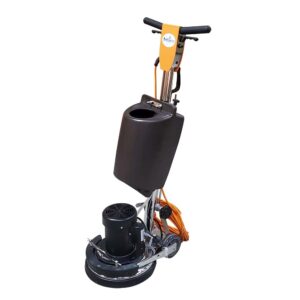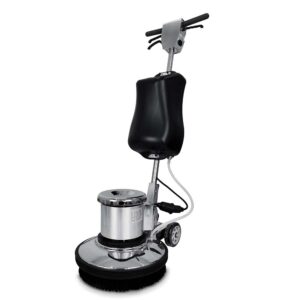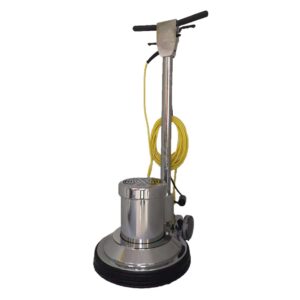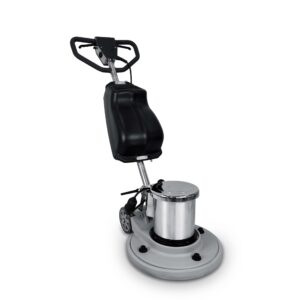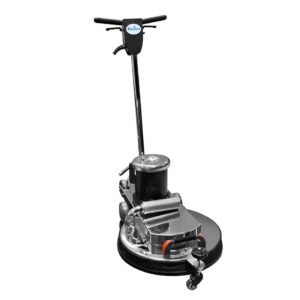Floor Polishers Machines In Toronto
Are you looking to make your floors shine? High-quality floor polisher machines in Toronto can transform your floors and make them look brand new. In this review, we'll walk you through everything you need to know about floor polishers in Toronto, including the different types, key features to look for, and tips for using them effectively.
Read more
Read less
What is a Floor Polisher Machine In Toronto?
Floor polishers, also known as floor polishing machines or floor buffers, are essential tools for keeping floors looking their best. These electric floor polishing machines use rotating brushes or pads to buff and polish floors. Floor polishers for sale come in different sizes and models like walk-behind floor polishing machines or ride-on floor polisher cleaning equipment that make it easier to cover large floor areas quickly. A floor polishing machine can help restore shine, remove scuffs and scratches, and prepare floors for new coatings of wax. From commercial floor polisher cleaning equipment designed for facilities to smaller electric floor polishers for home use, floor buffers for sale provide an efficient floor care solution. With the right floor polishing machine or floor cleaning machine, anyone can achieve professional-looking floor polishing results.
Floor polishing machines can be used on concrete, marble, tile, vinyl, and wood floors. They work by buffing away imperfections and sealing the floor surface to create an ultra-smooth, light-reflecting finish. The fast spinning action generates friction that heats up and softens wax sealants so they spread evenly across the floor. Floor polishing machines are more efficient and provide better results than walk behind floor scrubber, floor sweeper, or floor scrubber for polishing hard floor surfaces. Investing in a dedicated floor polishing machine is the best way to achieve gleaming floors.
Benefits of Using a Floor Polisher
Using a quality floor polisher offers many advantages compared to polishing floors by hand:
Enhanced shine Floor polishers buff floors to a much higher gloss than possible by hand. The fast spinning buffing pads smooth out micro-scratches and distribute glossy sealants evenly.
Time and labor saver Floor polishers can cover large commercial areas far faster than manual buffing. Time spent polishing floors is significantly reduced.
Consistent results The machines apply sealants and buff floors to a uniform finish across the whole surface area. Manual polishing can lead to uneven patches.
Improved durability Machine polishing better seals and protects floor surfaces, increasing resilience to traffic wear and tear. Less frequent re-polishing is needed.
Cost efficient Although floor polisher machines in Toronto involve an initial investment, they save money over time by increasing productivity and reducing labor costs.
Easier on the body Polishing floors by hand can be physically demanding. Floor polishers reduce strain on the back, knees, shoulders and other joints.
Types of Floor Polishers
There are three main types of floor polishers suitable for commercial and residential settings.
Electric Floor Polishers Toronto
Electric floor polishers are the most powerful option. They typically have a 15-20 inch buffing disc and operate on standard 110/120V household power. Industrial models may run on 220V circuits.
Electric floor polishers generate higher pad speeds ranging from 175 to 2000 RPM for fast, effective polishing. They offer continuous use and come with overload protection to prevent motor burnout. Electric models provide the best results on large floor areas.
- Most powerful option.
- Runs on standard household power.
- Offers high pad speeds for fast polishing.
- Ideal for large floor areas.
- Provides continuous use and motor overload protection
Battery Powered/Cordless Floor Polishers
Cordless floor polishers provide greater mobility and easier handling since there's no power cord to drag around. They run on rechargeable lithium-ion batteries and offer up to 2-3 hours of continuous runtime per charge.
While battery-powered models are not as robust as corded electric polishers, they work well for small-medium-sized floors up to 500 square feet. Lighter models are also more ergonomic and easier to maneuver into corners and under furniture.
- Offers mobility and easy handling without a power cord.
- Runs on rechargeable batteries.
- Suitable for small to medium-sized floors.
- Provides up to 2-3 hours of continuous runtime per charge.
- More ergonomic and maneuverable, especially in tight spaces.
Floor Buffers Toronto
Basic floor buffers differ from polishers in that they don't have a rotating brush or pad. Instead, they have an absorbent pad placed on the underside that buffs and burn floors as the machine is moved around.
Floor buffers are designed primarily for light buffing and dust mopping hard floors. They are less effective at deeper polishing compared to other machine types. On the plus side, floor buffers tend to be more affordable.
- Basic option without rotating brushes or pads.
- Uses absorbent pads for buffing and burnishing.
- Primarily for light buffing and dust mopping.
- Less effective for deep polishing but more affordable.
Top Floor Polisher Models
Here are some of the best floor polishers for commercial and home use:
P13 110V 220V Floor Polishing Machine A powerful, industrial-strength floor polisher with variable 175-600 RPM speed control. Designed for large commercial jobs.
P17A 110V/220V Floor Polishing Machine A high-performing 17-inch electric polisher with 1300 RPM spin speed. Includes splash guard and pad driver.
Mercury M17E Floor Polisher Durable 17-inch electric polisher with adjustable velcro pad driver and AC motor with thermal overload protection.
Choosing the Right Floor Polisher In Toronto
With so many floor polisher models available, it can be tricky to choose the right machine for your needs. Here are the key factors to consider:
Floor Surface Compatibility
Make sure the floor polisher is suitable for your specific floor types – wood, concrete, vinyl, marble, etc. Some models are designed for hard floor surfaces only.
Look at the recommended floor surfaces in the product specifications and match them to your floors. Getting this right ensures good polishing results.
Size and Power Requirements
Consider the floor area size to determine the ideal polisher pad diameter – larger areas need bigger 17-20 inch polishers. Smaller rooms can use compact 13-15-inch models.
Corded electric polishers provide the most power for large commercial floors. Battery models offer greater portability for residential use.
Know your power supply – some polishers run on 110V household voltage while heavy-duty models require 220V connections.
Maneuverability and Portability
Lighter polishers are easier to move around and handle. Maneuverability is especially important for polished tight spaces.
Battery-powered cordless models offer the most flexibility and mobility during use. Corded polishers require dragging a power cord around.
Choose a model with good ergonomics, an adjustable handle, and smooth gliding wheels to reduce fatigue.
Additional Features and Accessories
Here are some of the most important features to consider when choosing a floor polisher:
Power More powerful motors provide better polishing action but come with more noise and vibration. Look for at least a 1.5-horsepower motor.
Variable Speed Settings Multiple speed settings allow you to match the buffing speed to the job. Lower speeds help apply finish coats while higher speeds buff floors to a perfect shine.
Detachable Handles Handles that you can detach make the floor polisher much easier to store and transport.
Self-Lubricating Bearings Bearings that lubricate themselves require less maintenance and last longer.
Dust Control Features like dust skirts and filters help reduce airborne dust while operating.
Onboard Storage Storage for pads and brushes allows you to have everything at hand.
Cord Length Longer power cords in the 50-foot range provide more operating radius.
Weight-lighter polishers are more comfortable for extended use. Auto floor polishers should have wheels to reduce operator fatigue.
Using a Floor Polisher
Follow these basic steps to polish floors using a floor polishing machine:
- Sweep and thoroughly mop the floor area to remove dirt, debris, and contaminants. Rinse well and allow the floor to fully dry.
- Attach the appropriate polishing pad, brush, or applicator onto the driver mechanism as per the manual instructions.
- Plug in and turn on the polisher, starting at the lowest speed setting. Let it come up to operating speed.
- Apply the polishing solution, sealant, or wax to the floor area ahead of the polisher.
- Moving slowly in a sweeping motion, guide the polisher across the floor and over the product. Apply light pressure as needed.
- Once the entire floor is buffed, rinse the floor and pads thoroughly before applying another coat if necessary.
- Increase the speed setting if more aggressive buffing is needed to raise the gloss level.
- Turn off and unplug the polisher when finished. Remove pads/brushes before storing the machine.
Maintaining Floor Polishers
Follow these floor polisher care tips:
Cleaning and Lubrication
– Wipe down the housing and cords regularly using a damp cloth. Remove any splashed-on debris.
– Clean the pad driver and underside frequently to prevent product buildup.
– Lubricate bearings and gears as per the manual to maintain smooth performance.
Proper Storage
– Never put away a wet polisher – thoroughly dry all parts first.
– Wrap cords neatly and store the machine upright on its wheels with pads removed.
– Keep in a clean, dry location away from moisture and temperature extremes.
Floor Polishing Safety Tips
Floor polishing safety should always be a top priority:
– Wear eye protection, dust mask, and ear defenders when operating the machine.
– Post safety notices and barricade the area to keep bystanders away.
– Make sure electrical cords are undamaged and avoid excessive extension cord lengths.
– Don't leave a running polisher unattended – turn it off if leaving the area.
– Unplug when changing pads/brushes or making any adjustments.
– Maintain a firm grip and use both hands to control the polisher. Avoid sudden movements.
– Keep fingers, hair, and loose clothing away from the rotating pad or brush.
Floor Polishers Available in Various Cities
- Floor Polishers in Toronto
- Floor Polishers in Brampton
- Floor Polishers in Mississauga
- Floor Polishers in Vaughan
- Floor Polishers in Oakville
- Floor Polishers in Halton Hills
- Floor Polishers in Milton
- Floor Polishers in Woodbridge
- Floor Polishers in Maple
- Floor Polishers in Markham
- Floor Polishers in Scarborough
- Floor Polishers in Ajax
- Floor Polishers in Caledon
Get Your Floors Polished to Perfection
By following this floor polisher guide and using the right techniques, you can achieve showroom floor shine and maximum durability. Floor polishers save huge amounts of time and effort compared to manual buffing and make it easy to revive tired, dull-looking floors.
Investing in a quality floor polisher suited to your needs will provide reliable service for years to come. Be sure to maintain and store it properly between uses. And always put safety first when operating powerful.
FAQs (Frequently Asked Questions)
- What is the difference between a floor polisher and a floor buffer?
The main difference is that floor polishers have a rotating brush or pad that buffs and polishes the floor, while floor buffers use an absorbent pad that moves across the floor to buff. Floor polishers are more effective at deeper polishing.
- How do I choose the right floor polisher for my needs?
Consider the size of the area you need to polish, the type of floors, whether cordless or corded electric is better, the power level needed, variable speeds, and extras like splash guards. Match the polisher to your specific requirements.
- Can I use a floor polisher on different types of flooring?
Check the flooring compatibility in the polisher specs. Most can be used on concrete, vinyl, marble, wood, etc. But some are for hard floors only. Use the right pads for each floor type. Test and polish a small hidden area first.
- How often should I polish my floors?
For high-traffic commercial floors, polishing 1-2 times per week is ideal. Home floors only need polishing every 2-3 months typically. More frequent polishing is needed if floors get worn quickly. Let the floor condition guide you.
- Are floor polishers easy to maintain?
Basic maintenance like cleaning the housing, pads, and electrical components is straightforward. Lubricating the mechanical parts per the manual, inspecting wires, and checking for worn parts will keep polishers in good shape. Proper storage and drying is also key.
- Can I rent a floor polisher instead of buying one?
Yes, floor polishers are commonly available to rent from hardware stores and equipment companies. This allows you to polish floors occasionally without the cost of purchasing. Ensure polishers come with pads and accessories.
- Can I use floor polishers to remove scratches from floors?
Yes, they are effective at buffing out fine micro-scratches and blemishes from hard floors. Use polishing pads with increasingly finer grits to gradually smooth the flaws. Deep gouges may need professional refinishing.
- How can I troubleshoot common issues with my floor polisher?
Check for cord damage, debris stuck in brushes, worn brushes/pads causing vibration, loose parts, low lubricant levels, motor overheating, and improper pad pressure. Refer to the user manual for model-specific troubleshooting tips.







